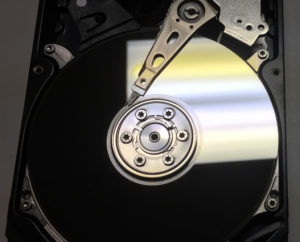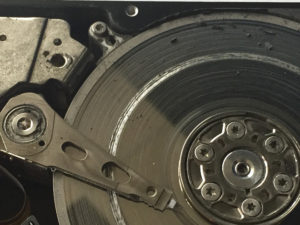
The exposed platters of a hard drive.
You’ve probably heard that opening a hard drive can cause instant data loss. This isn’t always 100% accurate — your data isn’t going to vanish in a puff of smoke or spill onto the floor the second that you open the enclosure.
But there’s a good reason for the hyperbole: Opening a drive can significantly decrease your chances of recovering your data, and it may lead to permanent data loss (particularly if the drive already has a physical issue).
Why Opening a Hard Drive is a Bad Idea
Hard drives are extraordinarily precise and sensitive. The internal components are designed to operate in a sealed environment free from dust, moisture, and other contaminants. That’s not to say that hard drives are airtight — they’re not — but filters ensure that the internal environment is free from particulates.
This environment is crucial because the read/write heads that access your data hover nanometers above the spinning platters. To put that in perspective, a human hair is roughly 75,000 nanometers thick.
To maintain this pristine environment, hard drive manufacturers assemble their drives in highly specialized cleanrooms. These rooms utilize HEPA and ULPA air filtration systems to remove potentially problematic particles from the air. Technicians wear full-body suits, gloves, and masks to prevent contamination from skin cells, hair, and fibers.
Opening a hard drive outside of this controlled environment introduces a host of potential problems:
- Dust Contamination: Even seemingly insignificant dust particles can cause catastrophic damage when they lodge between the read/write heads and the platters. This can lead to head crashes, scratching the platters and destroying data.
- Static Electricity: Electrostatic discharge can fry the delicate electronic components of the hard drive, rendering it inoperable. This isn’t especially likely, but it’s enough of a concern that all data recovery laboratories are outfitted with antistatic measures.
- Physical Damage: Improper handling can damage the read/write heads, platters, or other sensitive components.
- Oxidation: Exposure to oxygen can accelerate the corrosion of the platters, leading to data degradation (this is primarily an issue for water-damaged hard drives, but it’s still worth mentioning here).
Why Opening a Hard Drive Won’t Cause “Instant Data Loss”
As we wrote earlier, simply opening a hard drive won’t cause your data to magically disappear. The data is stored magnetically on the platters, and while opening the drive exposes it to risks, it won’t immediately erase the information.

This hard drive shows rough platter damage where the head remained in contact with the platters for several hours of operation.
However, any further manipulation of the drive can lead to severe damage and data loss. If the read/write heads are misaligned or contaminated, powering on the drive can cause them to scratch the platters, destroying data. The image to the right shows what that looks like — when those concentric circles of platter damage occur, there’s no way to reverse the damage or restore the lost data.
How Opening A Hard Drive Impacts Data Recovery
While opening a hard drive doesn’t guarantee data loss, it significantly reduces the chances of successful recovery. Data recovery companies often charge more for drives that have been opened because the risk of further damage is much higher.
Remember, you may only have one chance to recover your data. If the information is truly important, it’s best to entrust it to experienced professionals with the right tools and expertise.
Professional data recovery laboratories utilize specialized equipment, including:
- Class 100 Cleanrooms: These highly controlled environments prevent contamination during the recovery process.
- Specialized Tools: Data recovery engineers use proprietary tools to safely open drives, replace components, and image platters.
- Firmware Repair Equipment: Tools to diagnose and repair firmware issues.
Related: What Is a “Stuck Head” on a Hard Drive?
Trust the Leaders in Hard Drive Data Recovery
If you’re facing data loss, don’t risk further damage by attempting DIY data recovery. Contact the experts at Datarecovery.com. We have a proven track record of success and offer a no-data, no-charge guarantee, giving you peace of mind.
Submit a case online or call 1-800-237-4200 to start your free evaluation.




